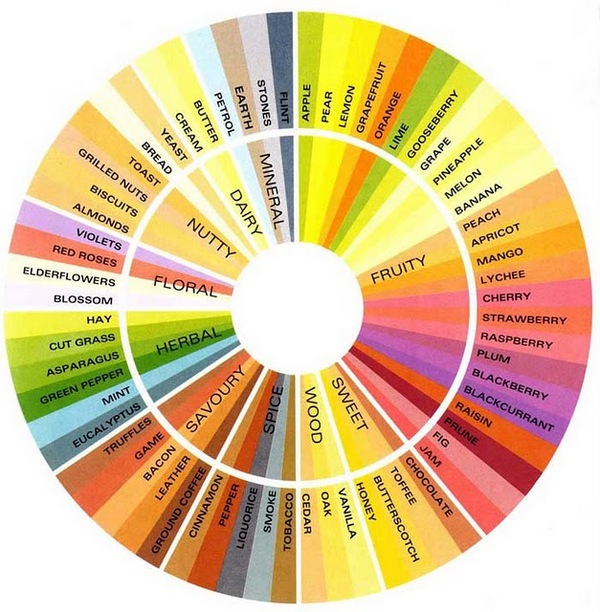How does tea taste? Why do two people drinking the same tea experiment two different things? And obviously which one of them is right? The answer is much more complex than we could think at first, which means that perhaps the two drinkers are wrong and right at the same time.
For the sake of my argumentation, I will take as hypothesis that the tasted tea is of good quality and perfectly brewed. This means that the difference in its tastes only come from the tasters themselves.
First thing, we usually lack training in tasting. We didn’t train hard enough to be able to focus on what we drink (or eat) and we lack the proper experience to understand what we taste and to be able to categorize it. Our inner taste library is in most cases not developed enough to cope with everything and to be able to express what we feel.
Just check this rather simple tea wheel to understand what I mean.
Tea Wheel from Whiskyrific
Probably because I never trained myself making me for that a newbie, I always thought of such wheel as the famous scene of the Matrix Movie.
“Operator. Tastes, lots of tastes”
https://www.youtube.com/watch?v=5oZi-wYarDs
The second thing is the link between tasting and smelling with our sense of smell being richer in our capacity to analyse things than the sense of taste. I don’t know how many receivers we have on our tongue but for smelling we have around 400 different ones, which allows us thanks to their combination to recognise at least 10,000 different smells (I wrote at least as according to recent studies, this number is more likely to be in billions or trillions).
Don’t start overreacting. A lot of these different smells are variants of another. The citrus are the perfect example of that as every member of this family can be recognized by smell but among the different oranges or lemons or…, there are different varieties, smelling almost the same as the others but not totally. And if you add to this the fact that they can cross-bred quite easily, mixing a little more their smells, you understand why we can probably recognise so many smells.
A good illustration of the richness of the taste of smell can be read in a book by Patrick Suskind, Perfume, the Story of a Murderer, in which the author describes with a vivid imagination the olfactory experiences experienced by the hero.
“This scent had a freshness, but not the freshness of limes or pomegranates, not the freshness of myrrh or cinnamon bark or curly mint or birch or camphor or pine needles, not that of a May rain or a frosty wind or of well water… and at the same time it had warmth, but not as bergamot, cypress, or musk has, or jasmine or daffodils, not as rosewood has or iris… This scent was a blend of both, of evanescence and substance, not a blend, but a unity, although slight and frail as well, and yet solid and sustaining, like a piece of thin, shimmering silk… and yet again not like silk, but like pastry soaked in honey-sweet milk – and try as he would he couldn’t fit those two together: milk and silk! This scent was inconceivable, indescribable, could not be categorized in any way – it really ought not to exist at all. And yet there it was as plain and splendid as day.”
It also seems that among our DNA, we have 800 genes dedicated to smell with up to 30% differences in them between (and we are small players when compared to dogs).
This also explains why some people are sensitive to certain smells (and able to detect them easily) or totally insensitive.
The last explaining factor is a huge psychological one. We are sensitive and social creatures and as such, the taste of tea might change depending on the weather conditions, the people we drink tea with (if you drink with loved ones or other people, the tea will taste differently), our own experience, the price when it is known (obviously a more expensive tea is better than a cheaper one…), the name when it is known (reputation effect), even the colour of the tea…
I lost you with the colour part? An experiment was made with a white wine and people tasted honey, lemon, grapefruit, elderberry… The same wine was given back for tasting but dyed with a odourless and tasteless product.
Guess what? The wine now tasted like red plums, chocolate…
Now that we have seen how much the taste of tea is not depending on us, what can we do about it? The answer is simple: train, train, train. Remember this library of tastes? The more we train, the bigger it will grow and thus the better we will be able to differentiate the taste components of our tea.
It won’t be perfect and another people might still taste something different but it will be a move in the direction of trying to better understand tea and its uniqueness.
